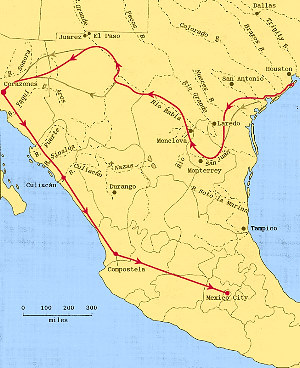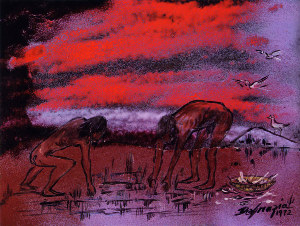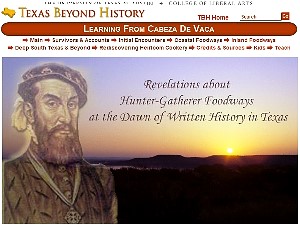Isla de Malhado
Somewhere in this area in 1528, Álvar Núñez Cabeza de Vaca and his shipwrecked companions made landfall on a barrier island of the upper Texas coast, which he named Isla de Malhado, or Isle of Misfortune. Historians believe it likely that it was Galveston Island or the Bolivar Peninsula where these first Europeans set forth on Texas shores. Indeed, there is intriguing evidence of early Europeans at archeological sites on these island, including the Mitchell Ridge cemetery site.
Exactly where the explorer and his desperate party came ashore may never be known, but there is a wealth of information regarding their seven-year trek across south Texas and Mexico, much of it spent in the custody of local native peoples. Cabeza de Vaca’s Accounts of the Disasters, published in 1542, chronicles his journey and the particulars of daily life among aboriginal peoples, including many fascinating insights into their economies, dietary habits, trade relationships, and customs.
The first accounts by Texas’ earliest ethnohistorian describe encounters with Indians on the upper coastal island which foreshadow the rich and dramatic narrative to follow:
…I went toward them [the Indians] and called to them and they came toward us and the best we could do was to assure them and assure ourselves, and gave them beads and hawk-bells, and each of them gave me an arrow, which is a sign of friendship, and by signs they told us they would return in the morning and bring us something to eat, because they did not have any [with them].
The next day, at sunrise, which was the hour that the Indians had told us, they came to us as they had promised and brought us much fish and some roots which they ate and which are like nuts, some large or smaller. The greater part of them is taken from under water and with great trouble. At evening they returned and brought us more fish and the same roots and they brought their wives and children so that they could see us, and thus they returned rich with hawk bells and beads that we gave them. And other days they came to visit us again with the same as the other time. -Cabeza de Vaca
Researchers believe that the first group the Spaniards encountered after arriving at Malhado were the Capoque Indians. These native peoples apparently were deeply upset when they saw several starving members of Cabeza de Vaca's group eating their dead comrades. The cannibalism may have been particularly puzzling to the natives because the dead were not enemies of the Spanish.
From the explorer we also learn that the Indians of the upper Texas coast lived on the barrier islands in the fall and winter, subsisting on fish and roots of aquatic plants in the lagoons. In spring, they moved inland where they hunted deer and small mammals, gathered other plants, roots, and berries, and dig oysters along the shoreline.
To learn more about Cabeza de Vaca’s journey and the native peoples of coastal and south Texas, see the 10-section exhibit on Texas Beyond History: Revelations about Hunter-Gatherer Foodways at the Dawn of Written History in Texas. The exhibit includes correlated interactive learning activities and a lesson for K-12 students.

|

|

Texas Beyond History’s exhibit on Cabeza de Vaca and the foodways of Native Americans in Coastal and South Texas provides a wealth of detail and imagery. See Learning from Cabeza de Vaca. |